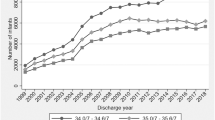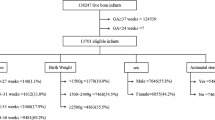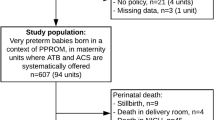Abstract
Objective:
The aim of this national population-based study was to identify perinatal and neonatal factors associated with active intensive treatment (AIT) of infants born at the periviable period of 22 to 24 weeks of gestation.
Study design:
Data from the Israel national very low-birth weight infant database on 2207 infants born alive in 1995 to 2010 at gestational age (GA) 22 to 24 weeks were evaluated. AIT was defined as endotracheal intubation in the delivery room or mechanical ventilation in the neonatal intensive care unit. Multivariable logistic regression analyses were used to identify the independent effect of demographic and perinatal factors on AIT for each gestational week.
Result:
Of the 2207 infants born at 22 to 24 weeks GA, 1643 (74.4%) received AIT and 564 (25.6%) received comfort care. AIT increased from 25.5% at 22 weeks to 62.7 and 93.5% at 23 and 24 weeks GA, respectively, reflecting a 4.66 (95% confidence interval (CI) 3.32 to 6.54)- and 29.8 (95% CI 19.9 to 44.6)-fold odds for AIT at 23 and 24 weeks GA, respectively, compared with 22-week GA infants. Perinatal treatments associated with AIT included maternal tocolytic therapy (odds ratio (OR) 1.51, 95% CI 1.04 to 2.20), prenatal steroid therapy, both partial (OR 3.30, 95% CI 2.14 to 5.10) and complete (OR 3.17, 95% CI 1.91 to 5.26) and cesarean delivery (OR 2.68, 95% CI 1.88 to 3.83). Each unit increase in birth weight z-score was associated with an OR of 1.58 (95% CI 1.30 to 1.92) for AIT. At 22 weeks GA, maternal tocolytic treatment was associated with higher odds of AIT. In the 23 and 24-week GA infants, maternal infertility treatment, antenatal steroids, cesarean delivery and higher-birth weight z-scores were significantly associated with AIT. Among 23-week GA infants, AIT decreased significantly in the period 2006 to 2010 compared with 1995 to 2000 (OR 0.51, 95% CI 0.34 to 0.77).
Conclusion:
An active approach in obstetric management of pregnancies appears to impact the neonatologists’ decision to undertake AIT treatment in infants born at the border of viability. The higher odds for AIT associated with obstetric interventions might contribute to the reported beneficial effect of antenatal steroids and cesarean delivery on the survival of infants born at the border of viability.
This is a preview of subscription content, access via your institution
Access options
Subscribe to this journal
Receive 12 print issues and online access
$259.00 per year
only $21.58 per issue
Buy this article
- Purchase on Springer Link
- Instant access to full article PDF
Prices may be subject to local taxes which are calculated during checkout


Similar content being viewed by others
References
Costeloe K, Hennessy E, Gibson AT, Marlow N, Wilkinson AR . The EPICure study: outcomes to discharge from hospital for infants born at the threshold of viability. Pediatrics 2000; 106: 659–671.
Wood NS, Marlow N, Costeloe K, Gibson AT, Wilkinson AR . Neurologic and developmental disability after extremely preterm birth. EPICure Study Group. N Engl J Med 2000; 343: 378–384.
Larroque B, Bréart G, Kaminski M, Dehan M, André M, Burguet A et al. Survival of very preterm infants: Epipage, a population based cohort study. Arch Dis Child Fetal Neonatal Ed 2004; 89: F139–F144.
Raju TN, Mercer BM, Burchfield DJ, Joseph GF . Periviable birth: executive summary of a Joint Workshop by the Eunice Kennedy Shriver National Institute of Child Health and Human Development, Society for Maternal-Fetal Medicine, American Academy of Pediatrics, and American College of Obstetricians and Gynecologists. J Perinatol 2014; 34: 333–342.
Rebagliato M, Cuttini M, Broggin L, Berbik I, de Vonderweid U, Hansen G et al. EURONIC Study Group. Neonatal end-of-life decision making: physicians’ attitudes and relationship with self-reported practices in 10 European countries. JAMA 2000; 284: 2451–2459.
Lorenz JM, Paneth N, Jetton JR, Den Ouden L, Tyson JE . Comparison of management strategies for extreme prematurity in New Jersey. Pediatrics 2001; 108: 1269–1274.
Singh J, Fanaroff J, Andrews B, Caldarelli L, Lagatta J, Plesha-Troyke S et al. Resuscitation in the ‘gray zone’ of viability: determining physician preferences and predicting infant outcomes. Pediatrics 2007; 120: 519–526.
AAP Committee on Fetus and Newborn. Noninitiation or withdrawal of intensive care for high-risk newborns. Pediatrics 2007; 119: 401–403.
Batton DG . Committee on Fetus and Newborn. Clinical report—antenatal counseling regarding resuscitation at an extremely low gestational age. Pediatrics 2009; 124: 422–427.
Nuffield Council of Bioethics. The ethics of premature delivery. Lancet 2006; 368: 1844.
Peerzada JM, Schollin J, Håkansson S . Delivery room decision-making for extremely preterm infants in Sweden. Pediatrics 2006; 117: 1988–1995.
Peerzada JM, Richardson DK, Burns JP . Delivery room decision-making at the threshold of viability. J Pediatr 2004; 145: 492–498.
Makhoul IR, Sujov P, Smolkin T, Lusky A, Reichman B Israel Neonatal Network. Epidemiological, clinical, and microbiological characteristics of late-onset sepsis among very low birth weight infants in Israel: a national survey. Pediatrics 2002; 109: 34–39.
Vermont-Oxford Trials Network Database Project Manual of Operations 1993. Vermont-Oxford Trials Network: Burlington, VT, USA Release 2.0 1993.
Bader D, Kugelman A, Boyko V, Levitzki O, Lerner-Geva L, Riskin A et al. Risk factors and estimation tool for death among extremely premature infants: a national study. Pediatrics 2010; 125: 696–703.
Kramer MS, Platt RW, Wen S, Wen SW, Joseph KS, Allen A et al. A new and improved population-based Canadian reference for birth. Pediatrics 2001; 108: E35.
Riskin A, Riskin-Mashiah S, Lusky A, Reichman B . Israel Neonatal Network. The relationship between delivery mode and mortality in very low birth-weight singleton vertex-presenting infants. BJOG 2004; 111: 1365–1371.
Malloy MH, Onstad L, Wright E . The effect of cesarean delivery on birth outcome in very low birth weight infants. National Institute of Child Health and Human Development Neonatal Research Network. Obstet Gynecol 1991; 77: 498–503.
Minguez-Milio JA, Alcázar JL, Aubá M, Ruiz-Zambrana A, Minguez J . Perinatal outcome and long-term follow-up of extremely low birth weight infants depending on the mode of delivery. Fetal Neonatal Med 2011; 24: 1235–1238.
Malloy MH . Impact of cesarean section on neonatal mortality rates among very preterm infants in the United States, 2000-2003. Pediatrics 2008; 122: 285–292.
Bauer J, Hentschel R, Zahradnik H, Karck U, Linderkamp O . Vaginal delivery and neonatal outcome in extremely-low-birth-weight infants below 26 weeks of gestational age. Am J Perinatol 2003; 20: 181–188.
Bottoms SF, Paul RH, Iams JD, Mercer BM, Thom EA, Roberts JM et al. Obstetric determinants of neonatal survival: influence of willingness to perform cesarean delivery on survival of extremely low-birth-weight infants. National Institute of Child Health and Human Development Network of Maternal-Fetal Medicine Units. Am J Obstet Gynecol 1997; 176: 960–966.
Markestad T, Kaaresen PI, Rønnestad A, Reigstad H, Lossius K, Medbø S et al. Early death, morbidity, and need of treatment among extremely premature infants. Pediatrics 2005; 115: 1289–1298.
Carlo WA, McDonald SA, Fanaroff AA, Vohr BR, Stoll BJ, Ehrenkranz RA et al. Association of antenatal corticosteroids with mortality and neurodevelopmental outcomes among infants born at 22 to 25 weeks’ gestation. JAMA 2011; 30: 2348–2358.
Tyson JE, Parikh NA, Langer J, Green C, Higgins RD . National Institute of Child Health and Human Development Neonatal Research Network. Intensive care for extreme prematurity: moving beyond gestational age. N Engl J Med 2008; 358: 1672–1681.
Onland W, de Laat MW, Mol BW, Offringa M . Effects of antenatal corticosteroids given prior to 26 weeks’ gestation: a systematic review of randomized controlled trials. Am J Perinatol 2011; 28: 33–44.
Mori R, Kusuda S, Fujimura M . Neonatal Research Network Japan. Antenatal corticosteroids promote survival of extremely preterm infants born at 22 to 23 weeks of gestation. J Pediatr 2011; 159: 110–114.
Håkansson S, Farooqi A, Holmgren PA, Serenius F, Högberg U . Proactive management promotes outcome in extremely preterm infants: a population-based comparison of two perinatal management strategies. Pediatrics 2004; 114: 58–64.
Condie J, Caldarelli L, Tarr L, Gray C, Rodriquez T, Lantos J et al. Have the boundaries of the ‘grey zone’ of perinatal resuscitation changed for extremely preterm infants over 20 years? Acta Paediatr 2013; 102: 258–262.
Holtrop P, Swails T, Riggs T, De Witte D, Klarr J, Pryce C . Resuscitation of infants born at 22 weeks gestation: a 20-year retrospective. J Perinatol 2013; 33: 222–225.
Zuckerman S, Mesner O, Zmora E . Living on the front line: ethical issues in the care of extremely premature newborns in Israel. Curr Pediatr Rev 2013; 9: 46–49.
Fellman V, Hellström-Westas L, Norman M . The EXPRESS Group. One-year survival of extremely preterm infants after active perinatal care in Sweden. JAMA 2009; 301: 2225–2233.
Tucker Edmonds B, McKenzie F, Hendrix KS, Perkins SM, Zimet GD . The influence of resuscitation preferences on obstetrical management of periviable deliveries. J Perinatol 2014; 35: 161–166.
Acknowledgements
The Israel National very low-birth weight infant database is supported partially by the Israel Center for Disease Control and the Ministry of Health.
Author information
Authors and Affiliations
Consortia
Corresponding author
Ethics declarations
Competing interests
The authors declare no conflict of interest.
Appendix 1
Appendix 1
The Israel Neonatal Network, which compiles the Israel national VLBW infant database, consists of these participating centers: Assaf Harofeh Medical Center, Rishon Le Zion; Barzilay Medical Center, Ashkelon; Bikur Holim Hospital, Jerusalem; Bnei Zion Medical Center, Haifa; Carmel Medical Center, Haifa; English (Scottish) Hospital, Nazareth; French Hospital, Nazareth; Hadassah University Hospital, Ein-Karem, Jerusalem; Hadassah University Hospital, Har Hazofim, Jerusalem; Haemek Medical Center, Afula; Hillel Yafe Medical Center, Hadera; Italian Hospital, Nazareth; Kaplan Hospital, Rehovot; Laniado Hospital, Netanya; Maayanei Hayeshua Medical Center, Bnei-Brak; Meir Medical Center, Kefar Saba; Misgav Ladach Hospital, Jerusalem; Poriah Hospital, Tiberias; Rambam Medical Center, Haifa; Rivka Ziv Hospital, Zefat; Schneider Children’s Medical Center of Israel and Rabin Medical Center (Beilinson Campus), Petach-Tikva; Shaare-Zedek Hospital, Jerusalem; Sheba Medical Center, Tel Hashomer; Soroka Medical Center, Beer-Sheva; Sourasky Medical Center, Tel Aviv; Western Galilee Medical Center, Nahariya; Wolfson Medical Center, Holon; Yoseftal Hospital, Eilat.
Coordinating Center: Women and Children’s Health Research Unit, Gertner Institute for Epidemiology and Health Policy Research, Tel Hashomer.
Rights and permissions
About this article
Cite this article
Litmanovitz, I., Reichman, B., Arnon, S. et al. Perinatal factors associated with active intensive treatment at the border of viability: a population-based study. J Perinatol 35, 705–711 (2015). https://doi.org/10.1038/jp.2015.48
Received:
Revised:
Accepted:
Published:
Issue Date:
DOI: https://doi.org/10.1038/jp.2015.48
This article is cited by
-
Survival and short-term respiratory outcomes of <750 g infants initially intubated with 2.0 mm vs. 2.5 mm endotracheal tubes
Journal of Perinatology (2022)



